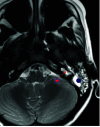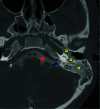Management of Meningitis Due to Cystic Cochleovestibular Malformation: a Stitch in Time
- PMID: 36742914
- PMCID: PMC9895605
- DOI: 10.1007/s12070-021-02519-7
Management of Meningitis Due to Cystic Cochleovestibular Malformation: a Stitch in Time
Abstract
Spontaneous CSF otorrhea alludes to those cases which have no known etiology like traumatic, iatrogenic, neoplastic or infectious. The presentation of the patient depends on the anatomical integrity of the eustachian tube as well as the tympanic membrane. Children with certain congenital inner ear malformations, including incomplete partition deformity, show a higher incidence of spontaneous CSF leaks and the resultant meningitis. Cystic vestibulocochlear deformity accounts for approximately 20% of inner ear malformations. In this case report, we discuss a child who presented with first episode of meningitis and with the help of thorough clinical otorhinolaryngological examination and radiology, was diagnosed with a congenital ear anomaly. With this paper, we stress upon the importance of keeping an open mind regarding the differential diagnosis of any condition, and the value of timely intervention.
Keywords: Cerebrospinal fluid (CSF) otorrhea; Computed tomography (CT); Congenital ear malformation; Cystic cochleovestibular anomaly; Meningitis.
© Association of Otolaryngologists of India 2021.
Conflict of interest statement
Conflict of interestThe authors declare that they have no conflict of interest.
Figures




Similar articles
-
A new classification for cochleovestibular malformations.Laryngoscope. 2002 Dec;112(12):2230-41. doi: 10.1097/00005537-200212000-00019. Laryngoscope. 2002. PMID: 12461346
-
Cerebrospinal fluid otorrhea secondary to congenital inner ear dysplasia: diagnosis and management of 18 cases.J Zhejiang Univ Sci B. 2019 Feb.;20(2):156-163. doi: 10.1631/jzus.B1800224. J Zhejiang Univ Sci B. 2019. PMID: 30666849 Free PMC article.
-
Rare Cases of Cerebrospinal Fluid Oto-Rhinorrhoea in Patients with Congenital Inner Ear Malformations.Indian J Otolaryngol Head Neck Surg. 2023 Dec;75(4):4101-4105. doi: 10.1007/s12070-023-04098-1. Epub 2023 Jul 21. Indian J Otolaryngol Head Neck Surg. 2023. PMID: 37974848 Free PMC article.
-
Life-threatening unilateral hearing impairments. Review of the literature on the association between inner ear malformations and meningitis.Int J Pediatr Otorhinolaryngol. 2015 Dec;79(12):1969-74. doi: 10.1016/j.ijporl.2015.09.028. Epub 2015 Sep 30. Int J Pediatr Otorhinolaryngol. 2015. PMID: 26453271 Review.
-
Efficacy of endoscopic repair for CSF otorrhoea in children with recurrent meningitis due to incomplete partition type 1.Int J Pediatr Otorhinolaryngol. 2022 Aug;159:111215. doi: 10.1016/j.ijporl.2022.111215. Epub 2022 Jun 28. Int J Pediatr Otorhinolaryngol. 2022. PMID: 35797929 Review.
References
LinkOut - more resources
Full Text Sources
